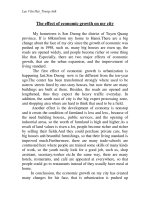Tài liệu The Committee on the Elimination of All Forms of Discrimination against Women (CEDAW) docx
Bạn đang xem bản rút gọn của tài liệu. Xem và tải ngay bản đầy đủ của tài liệu tại đây (137.71 KB, 9 trang )
1
July 24, 2007
The Committee on the Elimination of All Forms of Discrimination against Women (CEDAW)
Re: Supplementary Information about Brazil
Scheduled for review during the CEDAW’s 39th Session
Dear Committee Members:
This letter is intended to supplement the periodic report of the government of Brazil to the
Committee on the Elimination of Discrimination against Women (CEDAW Committee). The
Center for Reproductive Rights (the Center), an independent, non-governmental organization,
hopes to further the work of the Committee by providing information concerning the rights
protected in CEDAW. This letter highlights areas of concern related to the status of the
reproductive health and rights of women and girls in Brazil, with a focus on maternal mortality,
abortion and adolescents.
The Right to Reproductive Health Care (Article 12, together with Articles 1, 10 & 16 of
CEDAW)
Reproductive rights are fundamental to women’s health and social equality, and an explicit part
of the Committee’s mandate under CEDAW. The commitment of States Parties to uphold and
ensure these rights deserves serious attention. Specifically, article 12 requires that States Parties
“take all appropriate measures to eliminate discrimination against women in the field of health
care,” and specifically requires that governments ensure access to “appropriate services in
connection with pregnancy, confinement and the post-natal period, granting free services where
necessary, as well as adequate nutrition during pregnancy and lactation.”
1
Article 10(h) requires
that women have “[a]ccess to specific educational information to help to ensure the health and
well-being of families …”
2
The Convention also requires States to “take all appropriate measures
to eliminate discrimination against women in all matters relating to marriage and family relations
and in particular shall ensure, on a basis of equality of men and women: …[t]he same rights to
1
Convention on the Elimination of All Forms of Discrimination against Women, adopted Dec. 18, 1979, G.A. Res.
34/180, U.N. GAOR, 34
th
Sess., Supp. No. 46, at 193, U.N. Doc. A/34/46 (1979) (entered into force Sept. 3, 1981),
art. 12(2) [hereinafter CEDAW].
2
Id.
2
decide freely and responsibly on the number and spacing of their children and to have access to
the information, education and means to enable them to exercise these rights” [Article 16(1)(e)].
3
The Committee’s General Recommendation 24 on women and health affirms that “access to
health care, including reproductive health, is a basic right under [CEDAW]”
4
and is central to
women’s health and well-being.
5
Furthermore, it instructs States
Parties to take the following measures: “[e]nsure the removal of all barriers to women’s access to
health services, education and information, including in the area of sexual and reproductive
health,”
6
“… reduce maternal mortality rates through safe motherhood services and prenatal
assistance,”
7
and finally, to “[r]equire all health services to be consistent with the human rights of
women, including the rights to autonomy, privacy, confidentiality, informed consent and
choice.”
8
The CEDAW Committee has further stated that the duty to fulfill rights “places an obligation on
States parties to take appropriate legislative, judicial, administrative, budgetary, economic and
other measures to the maximum extent of their available resources to ensure that women realize
their rights to health care.”
9
The Committee has also noted that it is the “duty of States parties to
ensure women's right to safe motherhood and emergency obstetric services and they should
allocate to these services the maximum extent of available resources.”
10
We would like to direct the attention of the Committee to the following issues of concern that
directly affect the reproductive health and lives of women in Brazil:
A. Maternal Mortality
The CEDAW Committee has stated that high maternal mortality rates are an “important
indication for States parties of possible breaches of their duties to ensure women's access to
health care.”
11
Most maternal deaths are not complicated or expensive to prevent.
12
The majority of these
deaths are the result of hemorrhage, infection, or unsafe abortion, which health workers with
midwifery skills are capable of managing.
13
High-tech equipment and costly drugs are not
necessary to prevent and control leading causes of maternal death including shock, infection,
3
Id.
4
Committee on the Elimination of Discrimination against Women (CEDAW Committee): General
Recommendation 24, Women and Health, para. 1, U.N. Doc. A/54/38/Rev.1 (Part I) (1999) [hereinafter General
Recommendation 24].
5
Id. at para. 2.
6
Id. at para. 31(b).
7
Id. at para. 31(c).
8
Id. at para. 31(e).
9
Id. at para. 17.
10
Id. at para. 27.
11
Id. at para. 17.
12
OECD Observer, Maternal Mortality, Helping mothers live (December 2000), at
13
Id.
3
convulsions, and hemorrhage. Many surgical procedures like caesarean delivery likewise do not
necessitate expensive equipment or medication.
14
In addition to the right to health, the right to life is implicated in cases of maternal
mortality. The UN Human Rights Committee has instructed that protection of the right to life
“requires that States adopt positive measures.”
15
Because most maternal deaths are preventable,
States have a duty to adopt positive measures to prevent these deaths.
The World Health Organization (WHO) has estimated that in one year approximately
529,000 women die from pregnancy and childbirth related causes worldwide.
16
The majority of
these deaths occur in low and middle-income countries, while less than one (1) percent occurs in
high-income countries.
17
A study by the WHO indicates that in one year 22,000 women die from
complications related to pregnancy and childbirth in Latin America and the Caribbean.
18
In
Brazil alone, the WHO calculates that 8,700 women die from complications related to childbirth
and pregnancy every year.
19
The CEDAW Committee has expressed its concern at the high maternal mortality rate in
Brazil.
20
However, Brazil has not risen to the challenge of combating maternal mortality. As the
British Department for International Development, an agency that funds efforts to fight extreme
poverty, has noted, “[t]he main exception [in Brazil’s Millennium Development Goal progress]
is maternal health where the maternal mortality ratio has been rising reversing this trend will
be a major challenge.”
21
Despite the fact that Brazil accounts for over one-third of all maternal deaths in Latin
America, the government is not treating the problem with a corresponding level of urgency. Its
health priorities have neglected maternal health, as revealed in a recent survey conducted by the
Economic Commission for Latin America and the Caribbean. The Commission surveyed
seventeen Latin American countries in an effort to analyze the state of health and health-care
programs from the perspective of the health ministry in each country. One of the survey
questions asked each country to rank, in order of priority, its top three health problems. Brazil’s
response did not include any references to maternal health, whereas Bolivia, Guatemala, and
Nicaragua listed maternal and child mortality as their top health concern, and Peru identified
maternal mortality as its third most serious health problem.
22
The absence of maternal mortality
14
Id.
15
Human Rights Committee, General Comment 6, Article 6 (Right to life), para. 5, U.N. Doc. HRI/GEN/1/Rev.7
(1982).
16
WORLD HEALTH ORGANIZATION, MATERNAL MORTALITY IN 2000: ESTIMATES DEVELOPED BY WHO, UNICEF,
UNFPA 10 (2004) [hereinafter WHO, MATERNAL MORTALITY IN 2000].
17
Id.
18
Id.
19
Id. at 22.
20
Concluding Observations of the Committee on the Elimination of Discrimination against Women: Brazil, 29
th
Sess., 610
th
, 611
th
, and 616
th
mtgs., para. 126, U.N. Doc. A/58/38 (2003) [hereinafter CEDAW Concluding
Observations: Brazil].
21
Department for International Development, The Development Challenge for Brazil, p. 2, at
www.dfid.gov.uk/pubs/files/brazildevchallenge.pdf.
22
ECLAC, SOCIAL PANORAMA OF LATIN AMERICA 263 (2005). Brazil’s top three priorities were non-transmissible
4
in Brazil’s response is telling, particularly because its maternal mortality ratio is nearly
identical to that of Guatemala and Nicaragua.
23
Other indications of the Brazilian government’s health priorities point to
negligence in reducing maternal mortality. In its Multi-Year Plan for 2004-07, the
government identified seven priorities in the area of health, not one of which was the
reduction of maternal mortality.
24
As recently as August 2005, the United Nations Development Assistance
Framework Common Country Assessment for Brazil noted with concern high maternal
mortality rates and detrimental disparities in health care.
25
It stated that Brazil’s maternal
mortality rates are “considerably higher than those of countries with lesser levels of
economic development, and are generally conceded to be unacceptable.”
26
A government audit of maternal mortality monitoring and prevention efforts
revealed the inadequacy of current government efforts. The audit, carried out in 2000 by
the Tribunal de Contas da Uniao (TCU), Brazil’s Court of Audit, assessed the
performance of the national, state, and municipal committees and the Ministry of
Health’s technical units on maternal mortality.
27
The TCU found that all of the sources
consulted unanimously admitted an under-evaluation of the number of maternal deaths.
28
The TCU found that many of the maternal deaths were preventable, and were caused by
ailments such as hypertension, hemorrhage and infection.
29
In addition, the TCU found
that although 24 state committees on maternal mortality had been established, only 14 of
them were effective.
30
A separate assessment conducted the following year was no more
encouraging. According to that report, only 18 states were investigating maternal deaths.
Of those, only seven relied on systematic investigations conducted by regional and
municipal committees.
31
diseases, transmissible infectious diseases, and external causes (e.g., related to accidents and violent
behavior).
23
UNFPA, STATE OF THE WORLD POPULATION REPORT 89 (2007). Guatemala has a maternal mortality ratio
of 240 per 100,000 live births, Nicaragua has a ratio of 230 deaths per 100,000 live births, and Brazil has a
ratio of 260 deaths per 100,000 live births.
24
Pan American Health Organization, Country Health Profile: Brazil, 2001, available at
25
BRAZIL’S UNCT, A UN READING OF BRAZIL’S CHALLENGES AND POTENTIAL: COMMON COUNTRY
ASSESSMENT iii (2005), available at
26
Id. at 14.
27
BRAZILIAN COURT OF AUDIT, EXTERNAL CONTROL SECRETARIAT, GOVERNMENT PROGRAMS CONTROL
AND EVALUATION SECRETARIAT, TCU EVALUATION OF MATERNAL MORTALITY MONITORING AND
PREVENTION 8 (2003).
28
Id. at 11.
29
Id.
30
Id. at 13.
31
PRESIDENCY OF THE REPUBLIC, GOVERNMENT OF THE FEDERATIVE REPUBLIC OF BRAZIL, BRAZILIAN
5
Maternal mortality rates are high despite the fact that 91.5 percent of childbirths
are performed in public hospitals.
32
Approximately 66 percent of women who die from
pregnancy-related causes are completely dependent on the public health system to give
birth.
33
There are higher maternal mortality rates among black, indigenous, and single
women living in the poorest regions of Brazil.
34
A United Nations report on Millennium
Development Goals progress in Latin America notes that although there are high
maternal mortality rates among women from all income levels, “the fact that it is more
prevalent among women from lower socio-economic strata makes it a poverty-related
issue.”
35
Maternal mortality violates women’s right to equality and nondiscrimination. The
CEDAW Committee has explained that “[m]easures to eliminate discrimination against
women are considered to be inappropriate if a health care system lacks services to
prevent, detect and treat illnesses specific to women.”
36
The Brazilian government’s
failure to provide access to quality health care and treat conditions related to pregnancy
and childbirth constitutes a violation of women’s rights to equality and
nondiscrimination.
Further, where certain groups of women, in this case women of African descent
and poor women, are disproportionately impacted by maternal mortality, the right to
equality and nondiscrimination is also violated.
The government of Brazil has a legal duty to immediately address maternal
mortality and all of its underlying causes.
MONITORING REPORT ON THE MILLENNIUM DEVELOPMENT GOALS 52 (2004).
32
LATIN AMERICAN AND CARIBBEAN COMMITTEE FOR THE DEFENSE OF WOMEN’S RIGHTS (CLADEM),
PAPER OF THE BRAZILIAN WOMEN’S MOVEMENT REGARDING THE BRAZILIAN STATE’S COMPLIANCE WITH
CEDAW: PROPOSALS AND RECOMMENDATIONS 86 (2003), available at
33
Id.
34
CLADEM, Monitoring Alternative Report on the Situation of Maternal Mortality in Brazil to the
International Covenant on Economic, Social and Cultural Rights, at Executive Summary, available at
/>
35
PAHO, ECLAC, AND UNFPA, THE MILLENNIUM DEVELOPMENT GOALS: A LATIN AMERICAN AND
CARIBBEAN PERSPECTIVE 148, available at
36
General Recommendation 24, supra note 4, at para. 11.
6
B. Abortion
In 2003, the CEDAW Committee expressed its concern at the high rate of
clandestine abortion, and its causes.
37
When abortion is illegal, women are forced to resort
to clandestine abortions, which are performed under unsafe conditions and put women’s
lives at risk.
In Brazil, abortion is legal only to save the woman’s life or in cases of rape.
38
Illegal abortions are punishable by one to four years imprisonment for the person who
performs the abortion (with the consent of the pregnant woman)
39
,
and one to three years
imprisonment for the woman having the procedure done.
40
The CEDAW Committee has
previously characterized such an approach as punitive, rather than in the interests of
public health.
41
Despite these restrictive laws, abortions in Brazil are widely performed, with the
vast majority carried out under unsafe conditions. There are an estimated one to four
million abortions each year in Brazil.
42
Unsafe abortions account for 25 percent of the
cases of infertility, and they are the fifth leading cause of hospitalization among women.
43
According to data collected on the Brazilian Public Health System, in the year 2004,
243,988 Brazilian women were hospitalized because of induced abortion complications.
44
The criminalization of abortion disproportionately affects low-income women.
While women of greater economic means are able to afford safe, though illegal,
abortions, poor women are often forced to seek dangerous abortions from unskilled
providers. Inequitable access to safe services also contributes to the higher maternal
37
CEDAW Concluding Observations: Brazil, supra note 20, at para. 126.
38
Penal Code, Decree Law No. 2.848, Dec. 7, 1940, Special Section, title I, ch. I, art. 128, available at
(in Portuguese).
39
Id. at art. 126.
40
Id. at art. 124.
41
Consideration of reports submitted by States parties under article 18 of the Convention on the
Elimination of All Forms of Discrimination against Women, Combined initial, second, third, fourth and
fifth periodic reports of States parties, Brazil, Committee on the Elimination of Discrimination against
Women (CEDAW Committee), 29
th
Sess., p. 164, U.N. Doc. CEDAW/C/BRA/1-5 (2002) [hereinafter
Brazil Report].
42
International Women’s Health Coalition (IWHC), Abortion Rights are Human Rights: The September
28
th
Campaign, at
43
WORLD BANK: BRAZIL, MATERNAL AND CHILD HEALTH 21 (2002) [hereinafter BRAZIL: MATERNAL AND
CHILD HEALTH]; WORLD ORGANIZATION AGAINST TORTURE (OMCT), VIOLENCE AGAINST WOMEN: FOR
THE PROTECTION AND PROMOTION OF THE HUMAN RIGHTS OF WOMEN: TEN REPORTS/YEAR 2003 94 (2004)
[hereinafter OMCT, VIOLENCE AGAINST WOMEN]; Brazil Report, supra note 41, p. 170.
44
Portal da Saúde, at
7
mortality rates in rural areas.
45
In addition, poor women face an increased risk of
pregnancy due to inadequate and unequal access to contraceptives and sex education.
46
The Brazilian government has acknowledged that “[t]he implementation and
expansion of abortion services to assist the cases in which abortion is permitted by law, as
well as family planning services, are both urgent and fundamental to Brazilian women’s
health.”
47
Brazil must ensure that women are not forced to seek abortions under
clandestine, unsafe conditions. There is a critical need for a revision of abortion laws in
Brazil.
C. Adolescents
The health condition of young women in Brazil is a matter of concern and deserves
special attention, specifically regarding rates of HIV/AIDS infection and pregnancy, and
sexual abuse and violence.
The CEDAW Committee has recently expressed its concern about the increase in
the prevalence of HIV/AIDS among young women.
48
Adolescents account for 24 percent of mothers giving birth in Brazil.
49
Also, rates
of fecundity among young women have grown 26 percent since the 1990s.
50
In Brazil’s
less prosperous states, girls under 19 occupy more than half of all maternity beds, and
nearly half of all legal abortions are performed on girls under 20.
51
Low-income girls are
more likely to become pregnant due to an insufficient supply of contraceptives, restricted
access to reproductive and sexual health services, fear due to confidentiality concerns and
legal barriers such as parental notification requirements.
52
Social vulnerability and low
social hierarchy status are also important factors in understanding the high rates of
pregnancy among adolescents in Brazil, especially black girls.
53
45
International Women’s Rights Action Watch, Country Report: Colombia, 1997, available at
46
Id.
47
Brazil Report, supra note 41, at 170.
48
CEDAW Concluding Observations: Brazil, supra note 20, at para. 126.
49
Brazil Report, supra note 41, at 171.
50
Ministério da Saúde, Marco Teórico e Referencial Saúde Sexual e Saúde Reprodutiva de Adolescentes e
Jovens Versão Preliminar, 2006, p.17, available at
51
BRAZIL: MATERNAL AND CHILD HEALTH, supra note 43, at 22.
52
Brazil Report, supra note 41, at 171.
53
Ministério da Saúde, supra note 50, at 18.
8
Sexual abuse, which accounts for 13 percent of all domestic violence, is
perpetrated against girls 80 percent of the time; the majority of these young victims are
between two and 10 years old.
54
Every day throughout the country, girls and adolescents are subjected to diverse
forms of sexual exploitation and traffic. Despite laws rendering these activities illegal,
incidents of child abuse and exploitation have increased over the last several years.
55
Every
year, it is believed that approximately one million children enter the sex market.
56
High pregnancy rates, growing HIV/AIDS rates and high incidents of violence and
sexual abuse must be addressed by the Brazilian government.
We hope the Committee will also consider addressing the following questions to
the government of Brazil:
1. What steps are being taken to ensure that women have access to reproductive
health services, as well as the provision of contraceptive methods and the
dissemination of information regarding contraception?
2. What measures are being taken to reduce the high maternal mortality rates,
particularly among the most affected populations, namely women of African
descent and those with lower educational and income levels?
3. A report by Brazil’s Federal Parliamentary Commission of Inquiry found that
98 percent of all maternal mortality deaths are preventable.
Therefore, why is the
current maternal mortality ratio in Brazil higher than in 1990 and the same as
in 1995?
4. What measures are being taken to address the issue of unsafe abortion, a
primary cause of maternal mortality, particularly among poor women upon whom
the criminalization of abortion has a discriminatory effect?
5. What steps are being taken to address the increased feminization of
HIV/AIDS?
6. What efforts have been taken to enact and enforce laws to reduce rates of
violence against women, particularly in the domestic sphere, and to ensure
that the perpetrators of violence are punished?
7. What is Brazil doing to increase its collection and analysis of data
54
OMCT, VIOLENCE AGAINST WOMEN, supra note 43, at 78.
55
Id. at 86.
56
Id.
9
disaggregated by race, gender, age, economic status, and geography?
We appreciate the active interest that the Committee has taken in reproductive
health and rights, and the strong Concluding Observations and General Recommendations
the Committee has issued to governments in the past, emphasizing the need for
governments to take steps to ensure the realization of these rights. We hope that the
information presented is useful during the Committee’s review of Brazil’s compliance
with the provisions contained in the Convention.
If you have any questions, or would like further information, please do not hesitate
to contact the undersigned.
Sincerely,
Lilian Sepúlveda
Legal Adviser for Latin America and the Caribbean
International Legal Program









